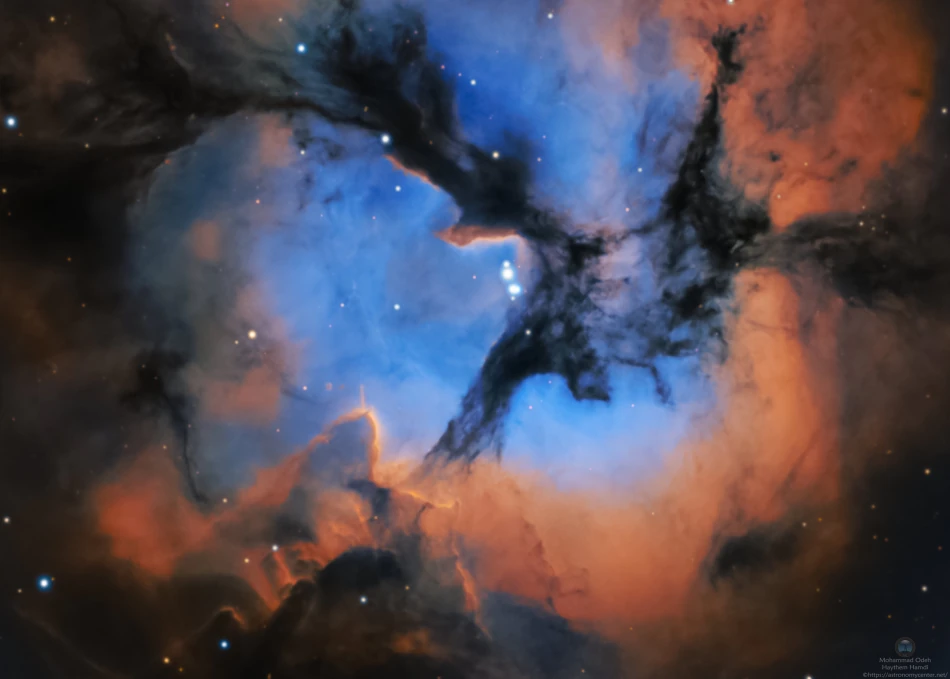
Celestial Seal Captures Birth of New Star in Orion Nebula Trio
Abu Dhabi Desert Observatory Captures Stunning 11-Hour Portrait of Star Birth in Deep Space
The Al Khatam Astronomical Observatory in Abu Dhabi's desert has successfully captured a breathtaking image of the Trifid Nebula, a stellar nursery located 4,100 light-years from Earth, following an intensive 11-hour photography session. The achievement showcases the UAE's growing capabilities in advanced astronomical imaging and positions the country as an emerging player in space science research.
The Trifid Nebula: A Cosmic Laboratory of Star Formation
The Trifid Nebula, officially designated M20, spans approximately 42 light-years in diameter and sits within the constellation Sagittarius. Its distinctive name derives from the three dark dust lanes that appear to divide the nebula into separate lobes, creating one of summer's most recognizable deep-sky objects for astronomers worldwide.
The newly captured image reveals intricate details of cosmic dust and gas clouds, illuminated by the intense radiation from newly formed stars. Most striking is a stellar fountain extending roughly three-quarters of a light-year in length, appearing as horn-like projections emerging from the nebula's gaseous heart. This phenomenon occurs when a nascent star's powerful energy output pushes surrounding gases outward, creating visible jets that mark the violent birth of stellar objects.
Technical Achievement in Challenging Conditions
The observatory team utilized a 14-inch telescope equipped with a monochrome camera to capture this celestial portrait. The imaging process required extraordinary patience and precision, involving 213 individual three-minute exposures taken over 11 consecutive hours. This technique, known as long-exposure astrophotography, allows astronomers to collect enough light from distant objects to reveal details invisible to the naked eye.
Advanced Filtering Techniques
The team employed three specialized filters to capture different elements within the nebula: hydrogen (76 images totaling 3.8 hours), oxygen (55 images totaling 2.8 hours), and sulfur (82 images totaling 4.1 hours). This narrowband imaging technique, popularized by the Hubble Space Telescope, enables astronomers to map the chemical composition of distant objects and create false-color images that highlight specific gases.
Remarkably, this achievement occurred despite operating in a Bortle 6 light pollution environment – a moderately bright suburban sky that typically hampers deep-space imaging. This demonstrates the observatory's technical sophistication and the team's expertise in overcoming challenging observing conditions.
UAE's Rising Profile in Space Science
This successful capture represents more than just a beautiful image – it signals the UAE's expanding ambitions in space science and astronomy. The achievement comes as the country continues building its space sector following the successful Mars mission with the Hope probe in 2021 and ongoing lunar exploration programs.
The UAE's investment in ground-based astronomy complements its space missions, creating a comprehensive approach to space science that rivals established programs in the United States, Europe, and Japan. Desert locations like Abu Dhabi offer natural advantages for astronomy, including clear skies, low humidity, and minimal atmospheric turbulence.
Scientific Significance Beyond the Image
The Trifid Nebula serves as a natural laboratory for understanding stellar formation processes that occurred throughout cosmic history, including the birth of our own Sun approximately 4.6 billion years ago. By studying such regions, astronomers gain insights into how stars form, evolve, and eventually die, enriching our understanding of galactic evolution and the cosmic recycling of elements necessary for planet formation.
The detailed imaging of stellar jets and gas dynamics within M20 provides valuable data for researchers studying the early stages of stellar development. These observations contribute to global databases used by astronomers worldwide to model star formation theories and predict the behavior of similar regions throughout the universe.
Most Viewed News

 Sara Khaled
Sara Khaled






